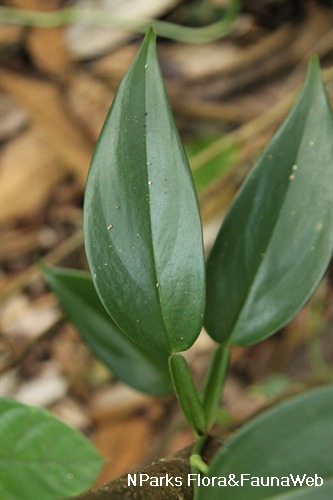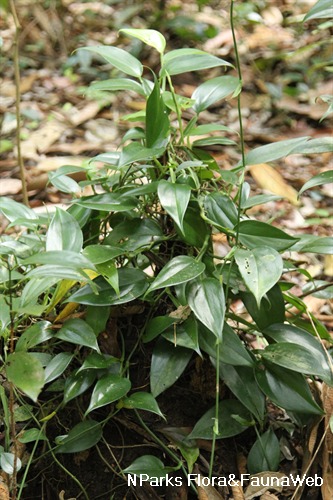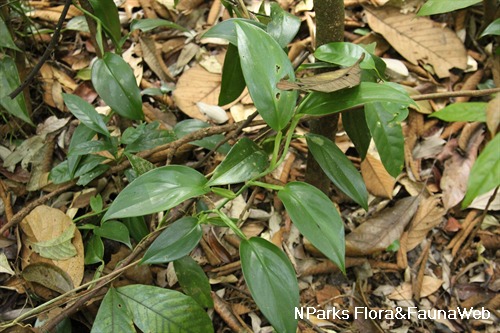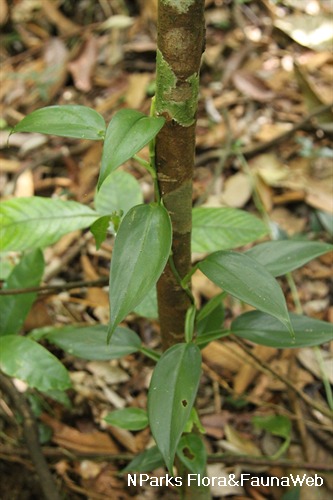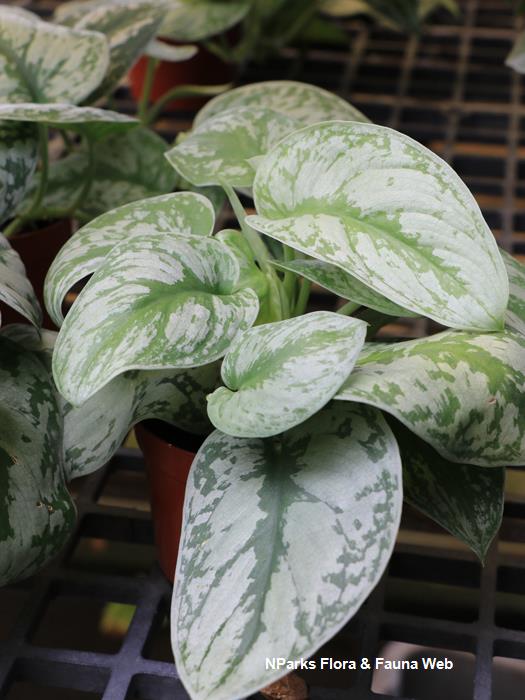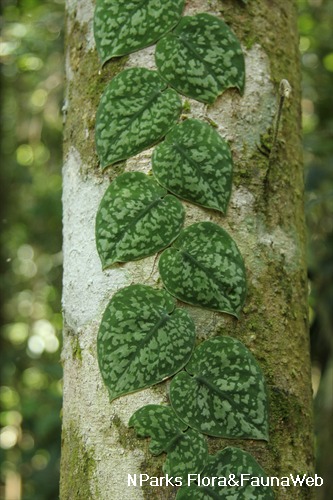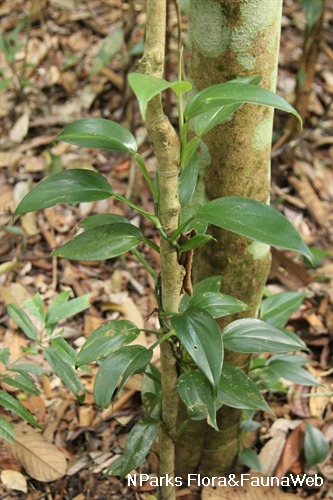
Back
Scindapsus hederaceus Schott
| Family Name: | Araceae |
| Common Name: | Akar Lebang Aleh, Akar Ular, Lowland Scindapsus |
Name
Classifications and Characteristics
| Plant Division | Angiosperms (Flowering Seed Plants) (Monocotyledon) |
|---|---|
| Plant Growth Form | Climber |
| Lifespan (in Singapore) | Perennial |
| Mode of Nutrition | Autotrophic |
| Plant Shape | Irregular |
| Maximum Height | 20 m |
Biogeography
| Native Distribution | Vietnam, Laos, Cambodia, southern Thailand, Sumatra, Peninsular Malaysia, Singapore, the Philippines, Borneo, and Java |
|---|---|
| Native Habitat | Terrestrial (Primary Rainforest, Mountain, Secondary Rainforest, Monsoon Forest, Freshwater Swamp Forest) |
| Preferred Climate Zone | Tropical |
| Local Conservation Status | Native to Singapore (Least Concern (LC)) |
Description and Ethnobotany
| Growth Form | It is a climber up to 20 m long. |
|---|---|
| Foliage | Its alternate, stalked leaves have deep green elliptic to broadly lance-shaped leaf blades that are 10–21 by 3–8.5 cm. |
| Flowers | Its flowers are found on a cylindrical, creamy white, 2.5–7 cm-long shoot (spadix) enclosed by a boat-shaped, yellowish-green, 4–8 cm-long, modified leaf (spathe). |
| Fruit | Its fruit is a red, 1-seeded berry. |
| Habitat | It grows in lowland and lower montane forests up to 1,500 m altitude on rocks and trees. |
| Associated Fauna | Its flowers are insect-pollinated. The ripe fruits are probably eaten by birds. |
| Cultivation | It can be propagated by seed or stem-cutting. |
| Ethnobotanical Uses | Medicinal: A decoction of the plant is used to make liniment for treating rheumatism. |
Landscaping Features
| Landscaping | A good native substitute for the numerous climber aroids grown ornamentally. It is suitable for planting in parks and gardens for its beautiful deep green foliage. It can also be grown as an indoor plant as it does not require much sunlight. |
|---|---|
| Desirable Plant Features | Ornamental Foliage |
| Landscape Uses | General, Parks & Gardens, Small Gardens, Interiorscape/ Indoor Plant, Container Planting, Suitable for Hanging Baskets, Terrarium |
| Thematic Landscaping | Naturalistic Garden |
Fauna, Pollination and Dispersal
| Pollination Method(s) | Biotic (Fauna) |
|---|---|
| Seed or Spore Dispersal | Biotic (Fauna) |
Plant Care and Propagation
| Light Preference | Semi-Shade, Full Shade |
|---|---|
| Water Preference | Moderate Water |
| Plant Growth Rate | Moderate |
| Rootzone Tolerance | Moist Soils, Fertile Loamy Soils, Easy to Grow |
| Propagation Method | Seed, Stem Cutting |
Foliar
| Foliage Retention | Evergreen |
|---|---|
| Mature Foliage Colour(s) | Green |
| Mature Foliage Texture(s) | Leathery, Thick |
| Prominent Young Flush Colour(s) | Green - Bluish Green |
| Young Flush Texture(s) | Leathery, Thick |
| Foliar Type | Simple / Unifoliate |
| Foliar Arrangement Along Stem | Alternate |
| Foliar Attachment to Stem | Petiolate |
| Foliar Shape(s) | Non-Palm Foliage (Lanceolate, Elliptical) |
| Foliar Margin | Entire |
Floral (Angiosperm)
| Flower & Plant Sexuality | Unisexual Flowers , Monoecious |
| Flower Colour(s) | Cream / Off-White, White |
|---|
| Flower Grouping | Cluster / Inflorescence |
| Flower Location | Terminal |
| Inflorescence Type | Spathe & Spadix |
Fruit, Seed and Spore
| Mature Fruit Colour(s) | Red |
|---|---|
| Fruit Classification | Simple Fruit |
| Fruit Type | Fleshy Fruit , Non-Accessory Fruit |
References
| References | Tan, P.Y., R.T. Corlett and H.T.W. Tan (Editors). 2010. A Field Guide to the Native Garden @ HortPark: an Urban Oasis of the Native Flora and Fauna of Singapore. Singapore: Centre for Urban Greenery and Ecology (National Parks Board) and National University of Singapore. 124pp |
|---|
Image Repository
Others
| Master ID | 31302 |
|---|---|
| Species ID | 5699 |
| Flora Disclaimer | The information in this website has been compiled from reliable sources, such as reference works on medicinal plants. It is not a substitute for medical advice or treatment and NParks does not purport to provide any medical advice. Readers should always consult his/her physician before using or consuming a plant for medicinal purposes. |

